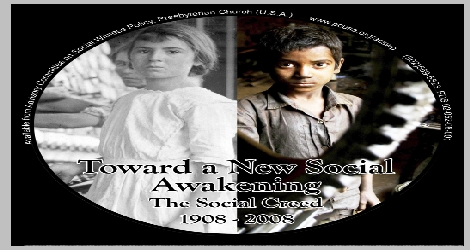[wpcol_1half id=”” class=”” style=””]
Low Wage Workers: The Needy Among Us Today
Individuals who earn the current federal minimum wage of $5.85[3] an hour and work full-time for fifty-two weeks a year will only earn $12,168 before taxes. This will barely raise them above the 2007 federal poverty guidelines of $10,210[4] for a single person and is nowhere near enough money to support a family. The current federal minimum wage is set to increase incrementally to only $7.25 an hour by 2009. Think for a moment about how much $34.00 a day can buy where you live in the United States. Would it be enough to afford a decent place to live? Adequate food? A reliable car? Necessary trips to the doctor? What if you were also supporting dependents and had to pay for daycare, clothe your children, or needed prescriptions to alleviate chronic illness? The vast majority of minimum wage workers also lack important benefits such as retirement and health insurance.
Many people assume that the average minimum wage worker is a teenager working at the local McDonald’s and still living at home with his or her parents. Others think that people working minimum wage or low wage jobs are unskilled and deserve low pay because of some fault of their own. Statistics show, however, that the average minimum wage worker is an adult woman, over twenty years old, who has earned at least a high school degree, and has family responsibilities. Minimum wage workers earn the lowest wage that employers are allowed to pay workers as established by federal law. According to the Economic Policy Institute (EPI), 79% of minimum wage workers are adults and 59% are women. The majority of minimum wage workers are white women. EPI estimates that thirteen million workers (10% of the workforce) currently earn less than the $7.25 federal minimum wage that goes into effect in 2009.
In addition, a larger percentage of African American and Hispanic workers earn poverty level wages when compared to white workers. A poverty level wage is defined as an hourly wage which if worked full-time and year-round does not earn enough to meet the Federal poverty standard for a family of four. For 2005, the federal poverty-level wage was $9.60 an hour. EPI found in its study on The State of Working America 2006/2007[5] that 29% of women workers and 20% of male workers earn a poverty-level wage. 37% of Black women and 29% of Black men; 35% of Hispanic men and 46% of Hispanic women earn a poverty-level wage.
More than thirty million Americans, about ¼ of the American workforce, work low-wage jobs. Low-wage workers earn more than the minimum wage but, as a family, typically earn two times the federal poverty standard. In 2007, the federal poverty guideline was defined for forty eight states, excluding Hawaii and Alaska, as $20,650 for a family of four.[6] The percentage of African-American and Hispanic workers affected by low wages is far higher than their overall representation in the workforce.
Many think that fast food restaurants employ the highest percentage of low-wage workers. In reality, jobs at fast food restaurants make up only a small percentage low paying jobs. Other low-wage jobs include the people whom we depend upon most to be skilled caregivers, such as day care providers, home health aides, and nurses’ assistants. Security personnel, food service workers and processors, cooks, maids, cashiers and pharmacy assistants, agricultural workers, laundry and dry cleaners also fall into the low wage category.
[/wpcol_1half] [wpcol_1half_end id=”” class=”” style=””]
These statistics became real to me when I met Lydia at the Salvation Army Center for Hope in Louisville, Kentucky. Crossroads, a local Catholic ministry with the mission to raise the consciousness of people of privilege by working with them to build relationships with those living in poverty, planned an immersion experience at the Salvation Army for students taking my class on Theology from the Margins. Our assignment was to break bread with the homeless and other impoverished people dining at the center. In conversations around our tables we learned that several of the people who were homeless worked full or part-time. I ate dinner with Lydia and her two children. Lydia worked full-time in a Laundromat, washing and folding clothes for customers paying by the pound for their laundry to be done. Although she and her children lived in low-rent temporary housing provided by the Salvation Army and ate dinner at the shelter most nights she expressed her optimism about her own future: “Things are gonna get better. I just need to get more education and get some benefits.” Lydia shares a belief held by many Americans. If she works hard enough and gets enough education then she will be able to “pull herself up by her bootstraps” and lift herself out of poverty.
Unfortunately, recent trends do not support such optimism. Political agendas often focus on education as the means to create economic upward mobility for people who are poor. Today, the majority of low-wage workers have earned a high school diploma. Some have even earned a college degree. In the past, education may have helped workers gain entrance into the middle class but upward mobility is becoming increasingly difficult even for those with some education. The Bureau of Labor Statistics reported in 2005 that between 2004-2014 the greatest growth in employment will be in the “service providing sector,” often the lowest paying occupations which do not require college degrees.
The circumstance of low-wage jobs generates a great deal of instability in workers’ lives. Low-wage jobs are more likely to require working non-standard hours, more rigid hours, and less stable hours. Unpredictable work schedules make it more difficult for a worker to plan for childcare, get an education, and keep in contact with one’s larger family and organizations that provide networks for support. Unstable income causes more frequent changes in residence including the increased likelihood of eviction, being forced to live without utilities, and, for children, more absences from school. Low income workers are at a disadvantage when trying to establish consumer credit making it difficult to afford reliable transportation. When credit is approved it is often at high interest rates. Many live without phone or internet service and opt to live with others or rent rooms in budget rate motels. Workers paid low wages have greater difficulty affording nutritious foods. Government subsidies for crops such as corn, wheat, and rice make carbohydrate heavy foods cheaper than healthier fruits and vegetables. Statistics show that about 38% of low wage workers receive health insurance from their employers compared to 69% of higher wage workers. Individuals and families without health insurance lack access to consistent medical care. Often medical care is simply unaffordable for low income families. In times of illness the only available medical care may be the emergency room which is extremely expensive.
These examples are not just anecdotal; they bring to life patterns that are becoming norms for workers. Beth Schulman, author of The Betrayal of Work, invites us to reconsider assumptions made about the responsibility placed upon individuals for their poverty. The accumulation of wealth of the people at the top of the employment ladder is linked to the poverty experienced by those at the bottom. Schulman argues that “the great secret of America is that a vast new impoverished population has grown up in our midst. Yet these are not Americans who have been excluded from the world of work; in fact, they make up the core of much of the new economy. Indeed, our recent prosperity rests, in part, on their misery. Their poverty is not incidental to their role as workers, but derives directly from it.”[7] Paying low wages allows businesses and corporations to offer low consumer prices, high stock prices, and puts billions of dollars of profits in the pockets of investors, CEO’s and other executives.
[/wpcol_1half_end]





Unbound Social